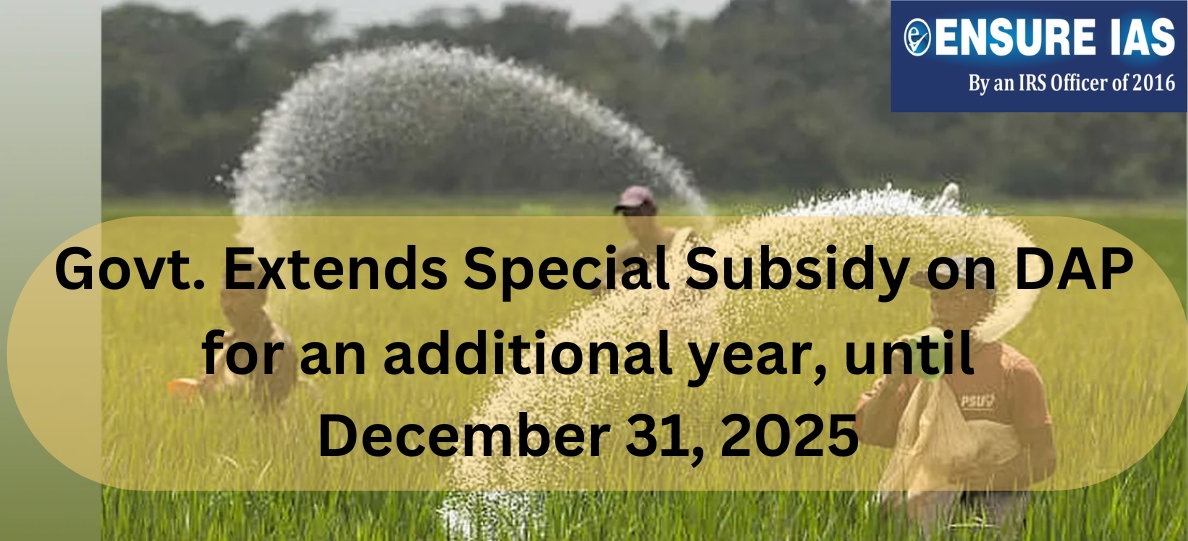- Courses
- GS Full Course 1 Year
- GS Full Course 2 Year
- GS Full Course 3 Year
- GS Full Course Till Selection
- CSAT
- 5 LAYERED ARJUNA Mentorship
- Public Administration Optional
- Online Program
- GS Recorded Course
- NCERT (Recorded 500+ Hours)
- Polity Recorded Course
- Geography Recorded Course
- Economy Recorded Course
- AMAC Recorded Course
- Modern India, Post Independence & World History
- Environment Recoded Course
- Governance Recoded Course
- Science & Tech. Recoded Course
- International Relations and Internal Security Recorded Course
- Disaster Management Module Course
- Ethics Recoded Course
- Essay Recoded Course
- Current Affairs Recoded Course
- ABOUT US
- OUR TOPPERS
- TEST SERIES
- FREE STUDY MATERIAL
- VIDEOS
- CONTACT US
Government Extends Special Subsidy on DAP: Implications and Industry Concerns
Government Extends Special Subsidy on DAP: Implications and Industry Concerns

- On December 31, 2024, the Indian government decided to extend the special subsidy on Di-Ammonium Phosphate (DAP) fertiliser for an additional year, until December 31, 2025.
- This subsidy, set at Rs 3,500 per tonne, was originally supposed to end at the end of 2024.
- The decision, which was approved by the Union Cabinet, aims to keep DAP prices stable for farmers.
- This is important because the weakening Indian Rupee (INR) has made DAP imports more expensive, making it harder to maintain affordable prices.
|
What is DAP (Di-Ammonium Phosphate)? DAP (Di-Ammonium Phosphate) is a widely used chemical fertiliser with the following key facts:
|
Reasons for Extending the Subsidy:
- Rising Fertiliser Prices: DAP is crucial for growing crops like wheat, rice, and oilseeds, and is the second-most used fertiliser in India.
- The government’s intervention aims to prevent sudden price hikes in DAP, which would affect farmers' expenses.
- Weakening Rupee: The Indian Rupee has fallen significantly against the US Dollar, from Rs 83.8 to Rs 85.7 in just three months.
- This has made importing DAP more expensive, and as a result, it has become more difficult to maintain the cost of fertilisers under control.
- Protecting Farmers: The extension of the subsidy aims to prevent a rise in farmgate prices of DAP, ensuring that farmers can still afford the fertiliser they need for upcoming sowing seasons.
Government’s Price Control Mechanism:
- Even though DAP and other fertilisers were officially decontrolled in 2010 (meaning that their prices could be determined by the market), the government continues to limit the prices through informal price caps.
- For example, the Maximum Retail Price (MRP) of DAP is Rs 1,350 per 50-kg bag (Rs 27,000 per tonne).
- This is despite the fact that companies should technically be allowed to adjust prices based on market conditions.
- For other fertilisers, the MRPs are set at Rs 1,300 to Rs 1,600 per 50-kg bag.
Challenges Faced by the Fertiliser Industry
- Higher Import Costs: The price of importing DAP has gone up significantly because of the weakening rupee.
- The landed import price of DAP is currently $632 per tonne, which converts to Rs 54,160 per tonne at the current exchange rate.
- This is a rise from Rs 52,960 per tonne when the rupee was stronger.
- Subsidy and Price Gap: The government provides a subsidy of Rs 21,911 per tonne for DAP, plus an additional Rs 3,500 per tonne under the special subsidy.
- This brings the total subsidy to Rs 25,411 per tonne. However, this amount is still lower than the import cost of Rs 54,160 per tonne, forcing fertiliser companies to cover the difference.
- This is becoming increasingly difficult as costs rise.
- Increased Operational Expenses: Fertiliser companies also face other costs, such as 5% customs duty, port handling, packaging, insurance, and dealer margins, which together add up to an additional Rs 10,000-12,000 per tonne.
- As a result, the total cost of importing DAP is now estimated at Rs 65,000 per tonne, making it unprofitable unless the government increases the subsidy or allows an increase in the MRP.
Industry’s Concerns
The fertiliser industry is raising alarm about the current situation:
- The industry points out that the current subsidy, together with the price cap, is no longer enough to cover rising import costs.
- They warn that if the government doesn’t increase the subsidy or raise the MRP, fertiliser companies may not be able to continue importing DAP.
- Fertiliser companies are asking the government to allow a small increase in the MRP of DAP to help them manage the rising costs.
- According to one industry representative, “We won’t be able to import DAP at these prices unless the government allows us to raise the MRP.”
- Changes in Policy: In September 2024, the government had agreed to fully compensate fertiliser companies for DAP imports if the landed price exceeded $559.71 per tonne (at an exchange rate of Rs 83.23 to the dollar).
- But with the rupee’s depreciation, these compensation calculations no longer match the real import costs, making them less useful.
Possible Solutions and Fiscal Impact
- Increase in Subsidy or MRP: To ensure that imports remain viable, the fertiliser industry is urging the government to either increase the subsidy or raise the MRP of DAP to reflect the actual costs.
- Without this adjustment, fertiliser companies might face difficulties in continuing imports, which could lead to shortages in supply.
- Fiscal Cost: The extra cost of extending the Rs 3,500 per tonne subsidy is estimated to be Rs 6,475 crore for the year.
- This adds to the government’s budgetary burden, which is already stretched with other subsidy programs.
- The government will need to balance the fiscal pressure with the need to keep fertiliser prices affordable for farmers.
- Political Factors: Since only Delhi and Bihar have elections in 2025, the government might face less political opposition to raising prices than it would in major farming states like Uttar Pradesh or Punjab.
- However, it is still likely to tread carefully to avoid angering farmers ahead of the kharif season.
Concerns About Fertiliser Supply
- Fertiliser Stock Levels: By mid-December 2024, the stock of DAP was 9.2 lakh tonnes, down from 13 lakh tonnes in 2023.
- Stocks of complex fertilisers stood at 23.7 lakh tonnes, down from 32.3 lakh tonnes the previous year. This indicates a potential shortfall in the supply of fertilisers.
- Risk of Shortages: If imports are not increased in the next few months, there could be shortages of DAP and other fertilisers in time for the kharif season (starting in June-July 2025).
- Without enough fertilisers, crop production could be affected, which would hurt farmers and the economy.
Conclusion
The government’s decision to extend the special subsidy on DAP is aimed at keeping fertiliser prices stable for Indian farmers, especially in the face of a weakening rupee. However, the extension of the subsidy is not a permanent solution. The fertiliser industry faces significant challenges due to rising import costs, and the government will need to decide whether to increase subsidies or allow a rise in MRP to ensure a steady supply of fertilisers. The next few months will be critical to assess whether the government can balance the fiscal cost of subsidies with the need to maintain fertiliser availability for the upcoming agricultural seasons.
|
Also Read |
|



